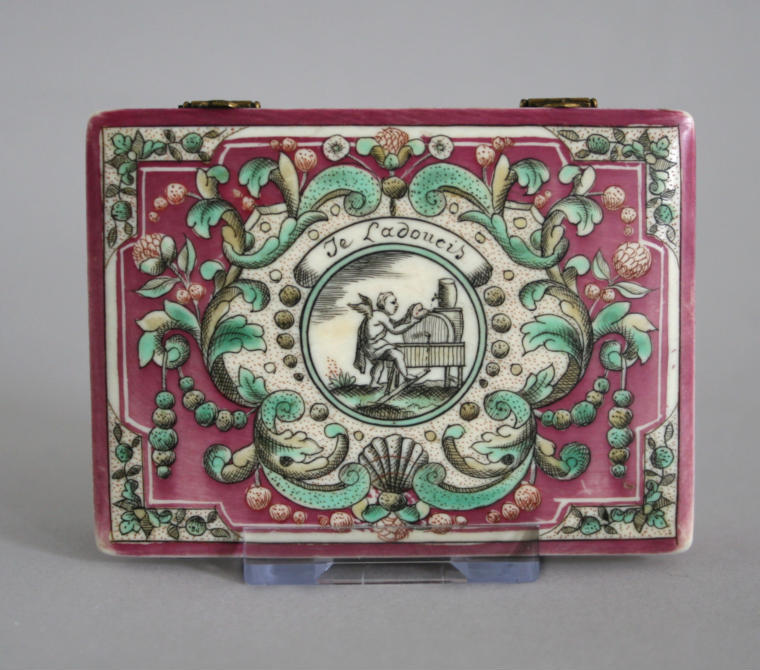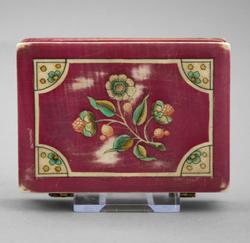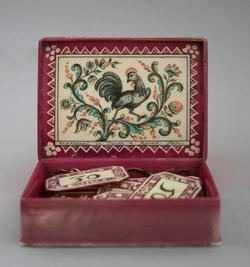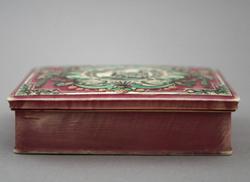Current Location: In storage
Titles
One of a set of four counter boxes
Maker(s)
Maker:
Mariaval, Le Jeune
Entities
-
Box
- counter box
- gaming token box
- boite à jettons
Categories
Description
Rectangular, ivory box painted in colours on a magenta ground; decorated on the lid with an emblem of Cupid at a grindstone, with a scroll above, inscribed 'Je ladoucis'
Ivory, stained, engraved and painted in magenta, black pink and yellow, with gilt metal hinges. Rectangular, the base with straight sides.The moulded sides of the lid projecting slightly over the base. The two projecting hinges are pinned to a metal scroll inside the box. The upper surface and interior of the lid and the base are engraved in outline in black and painted on a magenta ground. The top of the lid is decorated with a roundel of Cupid at a grindstone, a heart held in his hands against the stone, and his right foot on the pedal. The scroll above the roundel is inscribed 'Je ladoucis' (Je l'adoucis, I smooth it). The emblem is surrounded by scrolling foliage, flowers, pendant garlands and a shell in green, pink and yellow. At each corner is a swag of green fruit on a pink stippled ground.The inside of the lid is decorated with a cockerel surrounded by green, pink and yellow scrolling foliage and flowers within a black border beneath which is the inscription 'Mariaval le Jeune a Rouen fecit'.The base is decorated with a pink, green and yellow spray of three flowers in a white border. The box contains 19 long narrow counters decorated on both sides with a floral design on a magenta ground, and six elongated octagonal counters decorated on both sides with a magenta floral border, and numbered in black '5', '10', '20', '30' '40' or '50'. Each counter is drilled with a small hole near the edge. (with M.14 & A-R-1938, M.15 & A-Z-1938 and M.17 & A-X-1938)
Notes
History note: Sydney Ernest Kennedy (1855-1933); Christie, Manson & Woods, 18-22 March, 1918, Catalogue of the important collection of objects of art, antiquities, armour and arms formed by S.E. Kennedy, Esq. Who is giving up his residence 14 Brook Street, W, 5th day, 22 March, lot ; Leonard Daneham Cunliffe (1878-1937)
Legal notes
L.D. Cunliffe Bequest, 1937
Measurements and weight
Height: 2.2 cm
Length: 8.5 cm
Width: 6.3 cm
Acquisition and important dates
Method of acquisition: Bequeathed
(1938-02-15)
by
Cunliffe, Leonard Daneham
Dating
18th Century, second quarter
Circa
1725
CE
-
Circa
1750
CE
Note
Mariaval le Jeune was an engraver on ivory who signed boxes in Rouen and in Paris. His dates of birth and death are unknown but he was probably active in the second quarter of the 18th century. A box in the Victoria and Albert Museum is decorated with portrait profiles of Louis Ferdinand, Dauphin of France (1729-1765) and his second wife, Marie Josephe de Saxe (1731-1767) who did not marry until 1747. His speciality was the production of sets of counter boxes for use in card games, which were coloured to indicate the suits in a pack of cards: red (here a dark pink) for spades, green for diamonds, yellow for clubs and white for hearts. They contained counters of three shapes: long and narrow, elongated octagonal, and round. The circular ones ae missing from this box. (See M.14 & A-R-1938 M.15 & A-Z-1938, M.117 & A-X-1938) The Victoria & Albert Museum has a set of four boxes retaining all three shapes of counter (W.21A/1-1985), and have turning discs on the top for recording scores. They may have been used for reversis, an Italian card game which became popular elsewhere in western Europe in the 17th and 18th centuries.The object of the game was to avoid taking tricks, or exceptionally to take all.
The emblem on the lid, showing Cupid at a grindstone, was probably copied from emblem no. 6 on pl. XXIV of of Nicolas Verrien's 'Receuil d’emblêmes, devises, medailles, et figures hieroglyphiques . . .', Paris (Claude Jombert) 1724 or an earlier edition of 1696 published in Paris by Jean Jombert, but its motto is not the same as that printed on the following page. The first edition had been published in 1685 with the title 'Livre curieux et utile pour les Scavans et Artistes' (Bibliothèque nationale de France, 31565159). The emblem also appeared in Daniel de la Feuille's, Devises et emblèmes . . ., Amsterdam, 1691, p. 8, no. 1. But in both books, the text describes Cupid as sharpening an arrow, whereas on this box he is holding a heart against the grindstone.
School or Style
Rococo
People, subjects and objects depicted
Components of the work
Decoration
composed of
painting
Ivory
Materials used in production
Ivory
Inscription or legends present
- Text: Mariaval le Jeune a Rouen fecit
- Location: Inside the lid
- Method of creation: Inscribed
- Type: Signature
- Text: Je ladoucis
- Location: On the lid
- Method of creation: Inscribed
- Type: Motto
- Text: B / 22 / L.?
- Location: On the back between the two hinges
- Method of creation: Ink on paper
- Type: Paper label
References and bibliographic entries
Identification numbers
Accession number: M.16 & A-Y-1938
Primary reference Number: 166623
Stable URI
Audit data
Created: Saturday 6 August 2011
Updated: Tuesday 21 January 2025
Last processed: Wednesday 14 May 2025
Associated departments & institutions
Owner or interested party:
The Fitzwilliam Museum
Associated department:
Applied Arts







